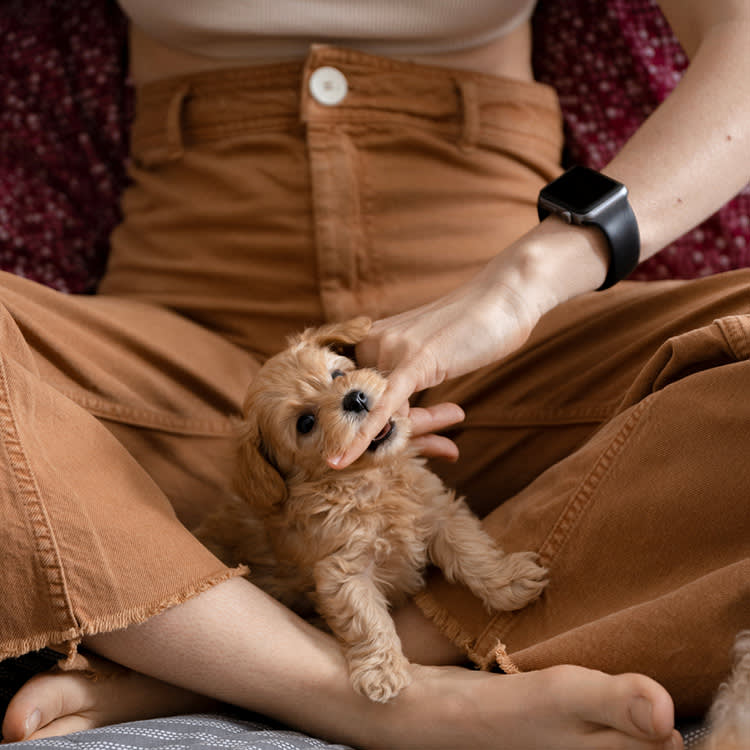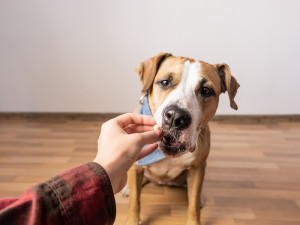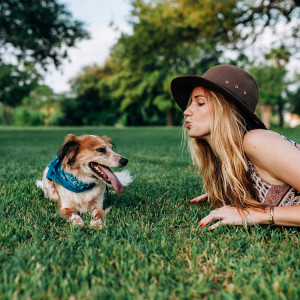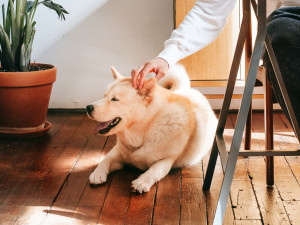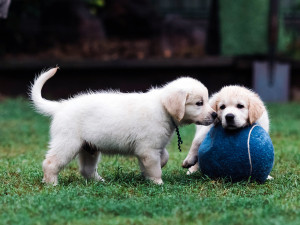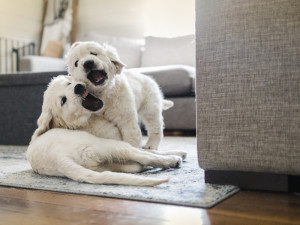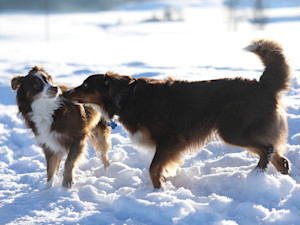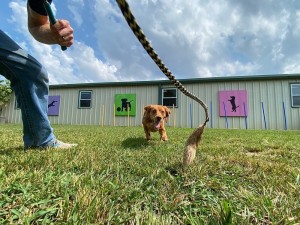What’s the Deal, Mouthy Puppies? Why Bite Inhibition Matters
How to teach your pup to play nice.
All dogs come equipped with powerful jaws and sharp teeth, but most save them for marrow bones, chews, or Kongs — a quality that makes for good pets and great friends. Unfortunately, your dog will likely experience unpleasant or stressful incidents at some point in their life (don’t we all?), but dogs with proper bite inhibition can consciously control their behavior and respond in a way that does not cause much (if any) damage. That’s why bite inhibition is so valuable.
If an injured or freaked-out dog air-snaps or inhibits their bite so effectively that contact with another dog or person causes no pain or injury, that’s a manageable problem by most people’s standards. If a dog with poor bite inhibition is in the same situation and inflicts serious damage, it’s a potentially disastrous problem from a physical, emotional, and even legal standpoint.
What is bite inhibition?
As puppies, dogs are typically taught to control the force of their bites. The degree to which dogs learn not to use the full force of their mouths on people and other dogs is called “bite inhibition,” and it is the most important part of a dog’s education.
Having good bite inhibition doesn’t mean a dog won’t kill squirrels or tear up their chew toys. Bite inhibition is all about exercising control in social situations, but that doesn’t necessarily apply to predatory behavior or playing with objects.
How much do you spend on your pet per year?
Why teach bite inhibition?
Bite inhibition is important because if a gate is left open, a leash breaks, or a person barges in unannounced, and your dog gets scared, they could bark, lunge, or snap. How they respond depends on their training. As a result, someone could be badly and even permanently injured, require medical care, such as surgery, or be deeply traumatized by an untrained dog. As a pet parent, you must be committed to working with your dog to improve their behavior. If you think your dog wouldn’t respond in such a manner, consider the following incidents from my own case files.
Stress involving children.
A visiting child loses his temper when the family dog distracts him during a game of ping-pong by yawning and whining. The child hits the dog in the face with the ping-pong paddle, and the dog runs away yelping. A teenager tries to dress up her dog to match her own outfit, and the dog resists. As she continues forcing the clothes on him, he whines and struggles. After several minutes, the dog growls and snaps at her face but makes no contact. A toddler tries to climb on her sleeping dog to ride him like a horse. The dog stands up and begins to walk away, but when she tries once again to get on his back, he bites her on the shoulder, causing a bruise.
Stress from accidents.
An elderly man trips and falls onto his dog while the dog is eating. The dog bites the man on the leg, leaving no mark. When a man reaches to pet his friend’s dog, his watch catches on the dog’s collar. He gently tries to disentangle himself, and the dog bites him on the leg, leaving two puncture marks and some bruising. A woman walks into her dining room, sees a dog toy under the table and reaches down to get it. Her dog, exhibiting extreme resource guarding, races in and bites her arm repeatedly, resulting in multiple punctures along with fractures to her wrist and arm that require several surgeries to fix.
It’s easy to see how a dog might become distressed. Yet, the dogs in each case responded differently, and the seriousness was not directly related to the injustice or pain suffered by the dog, but rather, to the dog’s ability to exercise proper bite inhibition. It’s no exaggeration to say that bite inhibition can be the difference between success and failure in treating behavior problems and even between life and death for the dog.
Early experiences
Experience with play-biting and mouthing often leads to better bite inhibition, and like anything else, those who practice become the most skilled. Littermates are a puppy’s first teachers, one of several reasons that it’s beneficial for puppies to stay with their litter for about two months. As the young dogs play, they use their mouths to tug or gnaw on their siblings’ ears, tails, paws, and loose skin. If one puppy mouths another too hard, the puppy who got hurt will yelp, stop playing, and move away. This teaches puppies that hard bites, even if not intended to cause pain, result in an interruption in play. Singleton puppies and those taken from their litter before the age of five or six weeks often lack proper bite inhibition. It seems that puppies need their littermates’ feedback to learn to control the pressure they exert with their mouths.
Once puppies head to new homes, their education needs to continue, and that includes socialization with other puppies and dogs. This does not mean throwing a puppy into the dog-park fray and hoping it will all work out. In that setting, puppies are far too likely to be overwhelmed and to experience it as we might experience a gladiator pit. Rather, it means supervised play dates with carefully selected and well-behaved canines.
Teaching bite inhibition
Lessons from people are also useful in teaching bite inhibition. Although using their mouths on our hands, arms, legs, hair, and clothes is natural behavior for them, dogs must learn to interact in ways that are appropriate in your world.
An effective technique, one based on puppies’ earlier experiences with their littermates, is to startle and then redirect the young offender. If a puppy mouths too hard, yelp with a puppy-like sound (Aaarp! is the closest description of this sound that can be spelled), which often interrupts the puppy’s biting. Take advantage of that pause in the behavior by immediately giving the puppy something appropriate to chew on. Good options include bones, chew toys, Kongs, squeaky toys, and stuffed animals.
1. Start with the hardest bites.
Begin by startling and redirecting the puppy only in response to the most forceful bites. Employing this approach with every instance of mouthing can be overwhelming to the puppy, who is, after all, doing what comes naturally and exploring the world by mouth. So, the first goal is to teach the puppy not to mouth so hard rather than not to mouth at all.
2. Next, work on lighter bite pressure.
When the hardest bites have been inhibited, the next step is to startle and redirect after medium-force bites. Spend time working at each level to ensure that your dog has a firm understanding.
3. Eliminate mouthiness altogether.
Finally, once the puppy has learned to mouth people with only the gentlest of pressure, teach them not to do this at all by employing the same technique in response to any occasion in which their teeth touch delicate human skin, hair, or clothes.
A common mistake when using this method is to make the yelping sound and then fail to redirect the puppy. In most cases, although the sound will startle the puppy into a break in the mouthing, they will go right back to it unless given another, more appropriate object to focus on. Many people begin by doing both steps (startle and redirect), but as time goes on, they switch to startling without bothering to redirect. It’s important to stay consistent.
While more than 90 percent of puppies will respond to this method if it is used correctly and consistently, some dogs seem to get worse in response to high-pitched yelps, becoming even mouthier and more revved up. For those dogs, it’s usually effective to startle the dog with a deep-voiced “Hey!” or “Ouch!” Otherwise, the technique of interrupting the behavior and then redirecting the dog to an appropriate object is the same. If the puppy fails to respond to either sound, walk away so that they learn that biting brings an end to the fun.
Mouthing myths
There are many recommendations out there for stopping puppy mouthing, and I advise against most of them because they are inhumane and generally ineffective. Do not hold the dog’s muzzle closed, yell at the dog, jam your fingers into the dog’s mouth, or swat the dog. Basically, it comes down to one piece of general advice: Don’t do anything that involves any kind of physical punishment that causes pain or frightens the dog.
Proper bite inhibition is incredibly important, and developing it requires lessons early in life. The normal process of learning bite inhibition is linked with puppy development and it can’t usually be learned later in life with the same degree of success. Dogs without this essential skill may cause severe damage — punctures, painful bruising, and even broken bones on occasion. Learning bite inhibition is one of the first and most essential lessons for puppies because it is about safety as well as being a well-behaved, polite member of society.
